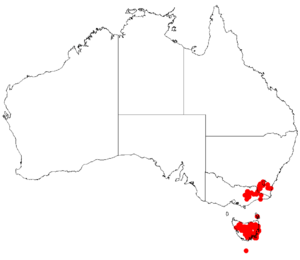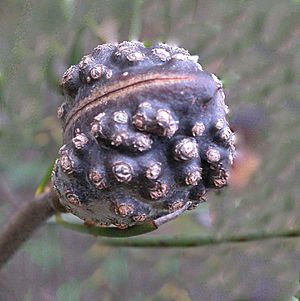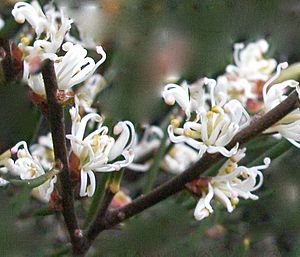Needle bush facts for kids
Quick facts for kids Mountain needlewood |
|
|---|---|
 |
|
| Scientific classification | |
| Genus: |
Hakea
|
| Species: |
lissosperma
|
 |
|
| Occurrence data from AVH | |
| Synonyms | |
|
|
The Hakea lissosperma, also called the needle bush or mountain needlewood, is a plant that grows in southeastern Australia. It is a type of Hakea plant.
Contents
About the Mountain Needlewood
The mountain needlewood is usually a shrub or a small tree. It often has spiky leaves. It can grow to be about 2 to 6 meters (7 to 20 feet) tall. This plant is a low, woody plant with several strong main branches.
Its leaves stay green all year. They are shaped like long, thin needles, usually 6 to 10 centimeters (2.4 to 3.9 inches) long. They are about 1.5 to 2 millimeters (0.06 to 0.08 inches) wide. The seed pods, called follicles, are hard. When they are young, they are about 20 to 30 millimeters (0.8 to 1.2 inches) long and 15 to 20 millimeters (0.6 to 0.8 inches) wide. Mature pods are a bit bigger, about 2.3 to 2.7 centimeters (0.9 to 1.1 inches) long and 1.7 to 2 centimeters (0.7 to 0.8 inches) wide. They often look rough or bumpy.
Flowers and Life Cycle
The mountain needlewood usually has white or cream-colored flowers. These flowers grow in thick bunches where the leaves meet the stem. Each flower bunch grows on a small stalk, usually 4 to 6 millimeters (0.16 to 0.24 inches) long. The flower parts, called the perianth, are smooth and about 5 to 6 millimeters (0.2 to 0.24 inches) long.
Flowers usually appear in late spring and early summer. This is between October and December in high mountain areas. In lower places, they bloom earlier. After the flowers, hard fruits grow. These fruits turn brown or grey-brown when they are ready, usually in the second year after flowering. The plant often holds onto these fruits for several years.
Each seed is about 17 to 23 millimeters (0.7 to 0.9 inches) long and 6.5 to 10.5 millimeters (0.26 to 0.41 inches) wide. The seeds are wrinkled and have a wing on one side. They are dark blackish-brown.
Plant Names and History
The scientific name for this plant, Hakea lissosperma, was first officially described in 1810. This was done by a botanist named Robert Brown. He wrote about it in a scientific paper. The first plant sample used to describe the species was found in Tasmania. It was collected in the mountains between the Derwent River and the "Heron" River.
The second part of its scientific name, lissosperma, comes from two old Greek words. Lissos means "smooth" or "polished." Sperma means "seed." So, the name describes its seeds.
Where it Grows
You can find Hakea lissosperma in several parts of southeastern Australia. It grows in Tasmania, Victoria, New South Wales, and the Australian Capital Territory.
In Tasmania, it is common in many areas, including the Central Highlands and near Hobart. In Victoria, it grows in the eastern parts, like East Gippsland and the Victorian Alps. In New South Wales, it is only found in the high mountain areas in the southeast, around the Australian Capital Territory.
Where it Lives
This plant often lives in wet Eucalyptus forests. It is very common, especially on mountains up to 1,200 meters (3,900 feet) high. It can also grow down to sea level in places that get a lot of rain.
The mountain needlewood is tough! It can handle frost and dry periods, which helps it survive in its natural home. It can also be found in drier forests at about 700 meters (2,300 feet) in parts of Victoria. It likes places that are moist and shady. It grows well in rich, loamy soils, but it doesn't like too much phosphorus.
Growing Your Own
If you want to plant a mountain needlewood, choose a spot that is protected from strong winds. You can collect seeds from the plant at any time of year. Just make sure to pick older, grey-brown fruits.
To get the seeds out, you might need to soak the fruits in water. Dry fruits usually open in 2 to 3 weeks. You can also put them in an oven at 80 to 100 degrees Celsius (176 to 212 degrees Fahrenheit) for 30 minutes with the door slightly open. Once planted, the seeds usually take about 6 months to sprout.
Birds love this plant! Its thick bunches of flowers attract them. The sharp, needle-shaped leaves also offer a safe place for birds to hide from predators. Animals usually don't eat this plant because it doesn't taste good to them.




